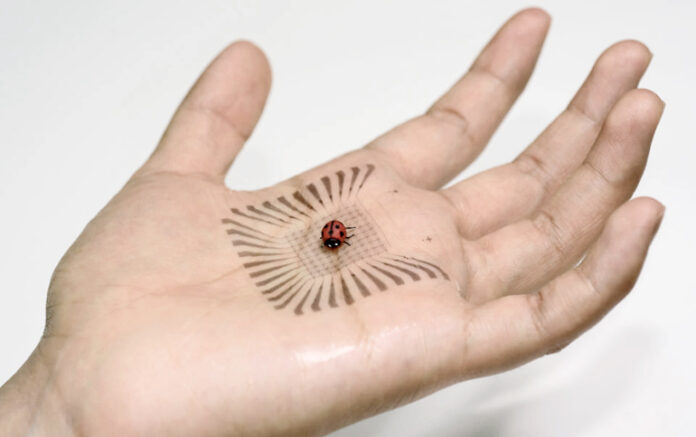New research sets the stage for an evolution in electronics by taking the concept of “artificial skin” to the next level. The work demonstrates not only a stretchable circuitry that can feel the touch of a ladybug, but also a manufacturing process to mass-produce this circuitry.
Restoring some semblance of touch to people who use prosthetic limbs has been a driving force behind Stanford University chemical engineer Zhenan Bao’s decades-long quest to create stretchable, electronically sensitive synthetic materials.
Bao’s hope is that manufacturers might one day be able to make sheets of polymer-based electronics embedded with a broad variety of sensors, and eventually connect these flexible, multipurpose circuits with a person’s nervous system. Such a product would be analogous to the vastly more complex biochemical sensory network and surface protection “material” that we call human skin, which can not only sense touch, but also temperature and other phenomena.
Bao says their production process involves several layers of new-age polymers, some that provide the material’s elasticity and others with intricately patterned electronic meshes. Still, others serve as insulators to isolate the electronically sensitive material. One step in the production process involves the use of an inkjet printer to, in essence, paint on certain layers.
The team has successfully fashioned its material in squares about two inches on a side containing more than 6,000 individual signal-processing devices that act like synthetic nerve endings.
The prototype can be stretched to double its original dimensions—and back again—all the while maintaining its ability to conduct electricity without cracks, delamination, or wrinkles. To test durability, the team stretched a sample more than one thousand times without significant damage or loss of sensitivity. The real test came when the researchers adhered their sample to a human hand.
“It works great, even on irregularly shaped surfaces,” says postdoctoral scholar Jie Xu, and the paper’s other co-lead author.
Perhaps most promising of all, the fabrication process described in this paper could become a platform for evaluating other stretchable electronic materials developed by other researchers that could one day begin to replace today’s rigid electronics.
Bao says much work lies ahead before these new materials and processes are as ubiquitous and capable as rigid silicon circuitry. First up, she says, her team must improve the electronic speed and performance of their prototype, but this is a promising step.
Analysis
This developing technology can elevate already existing technology on artificial skins and prosthetics. I feel the one thing that can make a prosthetic or injured hand beyond what is already there, is for the sense of touch to be possible. There are many things that the sense of touch can influence and for some, the sense of touch is an integral part of not only their curiosity but also learning. For some, being able to feel and touch somethin is how they learn and fuel their interest, and for those that have lost that ability to do so, this technology can possible help regain that back for them. A sense of touch is something we often overlook and take for granted, and being able to add that sense back to someone’s life can elevate already existing technology.




